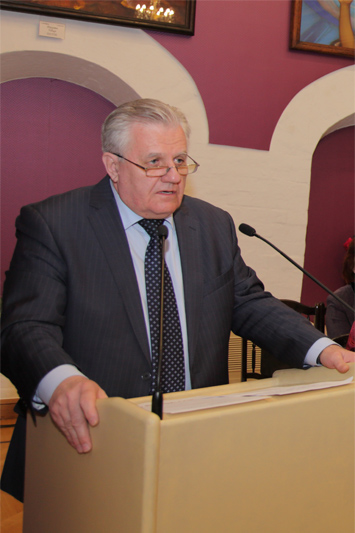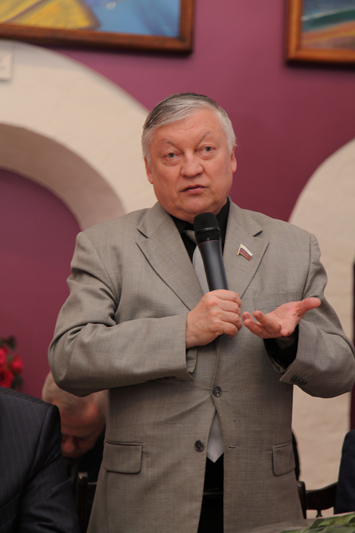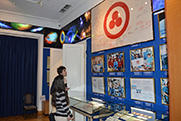|
April 15, 2017 a ceremonial evening dedicated to eighty-second anniversary of the sighing of the Roerich pact was organized in non-governmental museum named after Nicholas Roerich. On this important day in 1935 the first international treaty with the aim of preserving objects of cultural heritage of human creative genius. The Roerich Pact argued that the preservation of cultural monuments during military operatons and peacetime is the first step to the strengthening of international stability and the future of the Earth. This very pact served as a prototype of the Hague Convention (1954) and the world famous UNESCO which was founded with the humanitarian and peacekeeping purpose.
The movie dedicated to the Roerich Pact and the protection of cultural heritag opened the festive program. Images of destruction of the monuments of world cultural heritage were shown in view of threats to the preservation of mankind as a kind of living sentient beings. Two World wars that were in the twentieth century brought the culture on the decline. Human pride has put material gain above the spirit and the culture. Hence there are tragic histories of Flanders, Belgium, the Netherlands and throughout Europe. Antagonistic mechanisms that were thrust during the war have already become chronic. They continue to envolve nowadays. During this time of international concerns and global anxiety the idea of Nicholas Roerich "Peace trough Culture" sounds as the alarm bell.
In 1931 the first consecration of the symbol of the Roerich Pact – the banner of Peace was held in the Basilica of the Holy Blood in Bruges in Europe. Representatives of about 100 countries participated in the solemn meeting and supported the idea of Roerich about the creation of a normative international instrument , they heard the bells of victory ringing in honor of the consecration of the banner of the Trinity. In 1932 the conference dedicated to the Roerich Pact was held again in the luxurious Gothic hall of Bruges. The exhibition of the ancient monuments and ancient cities of the world was dated to the forum. It was suggested to admit Bruges, Rome and Venice inviolable and withdraw from their territories all the military garrisons.
In 1935 in the White House U.S. President Franklin D. Roosevelt made a solemn speech of the necessity of zeal of the cultural heritage of mankind as the guarantor of the preservation of the modern civilization. As the Red Cross protects the wounded and civilians at the front as the Banner of Peace is required to mark and protect a unique culture.
The audience was shown a video of UNESCO Director-General Ms. Irina Bokova with an appeal to stop the war in Syria. She called the Syrian events a cultural tradegy. The resolution of this conflict today is the presevation of peace in the world tomorrow. The diplomat appealed: "Enough destruction! Let's protect the world's common cultural heritage. Stop the war now!"
Also among the honorary guests at the evening in the museum named after Nicholas Roerich there were the Ambassador of Peru to the Russia Federation – Mr. Benjamin Chima, the head of the department of culture of the Embassy of Venezuela to the Russian Federation- Mrs. Maria Gabriela Ruiz Flores. They appreciated with an interest the exhibition halls of the museum and expressed their solidarity to the ideas of the Roerich Pact and expressed the wish that it would be more appropriate to celebrate world Culture Day not only in public but also in thre state level.

|
|
|
Alexander Stetsenko
|
|
Vice-president of the ICR Alexander Stetsenko congratulated all the participants with the 82nd anniversary celebration of the Roerich Pact – a treaty aimed at absolute protection of all cultural heritage both during wartime and peacetime and not only objects themselves but of the staff working with them. The treaty was named after its founder and inspirer.
This event determinated the development of mankind in the long term. The Roerich Pact has received international recognition thanks to a grassroots movement. This demonstrates the value and power of public opinion and that the participation of social forces in cultural development is a panacea to solve many social problems.
Why do culture and its objects play such an important role? Culture in the broadest sense of is meaning ,according to the Living Ethics, is the basis of formation of the person and as a personality, forming of his spirit. In the space of culture human evolution happens through the discovery of their highest potential for the good of inkind.
Culture is the store of energy of beauty without which humanity simply will become wild. The cultural objects of antiquity, religious temples, the best examples of architecture, classical music, painting, the highest patterns of literature and poetry, scientific discovery and mahe other objects of hig creativity of humanity keep this indestructible energy. Contact with the harvests of high culture ennobles and enrihes a person spiritually.
The picture if it is written by the great master carries a huge potential of beauty and its supply does not depend on the time of its creation. Visual communication of the audience with a picture is full of an unusual meaning. The value of museums is extremely important. They are powerful centers of culture. That is why in the first place in the name of the Pact there are art institutions. Their preservation, development and enhancement is the key to the developmemt of the state , which shall care for and create al the necessary conditions for the museums.
High poetry, clasical music connect us with their creators and with the higher, where artists and musicians were inspired. Without these masterpieces future is impossible. Nicholas Roerich wtote: "The destruction of the museum is the destruction of the country." Today we see how conflicts become from local to state, and there is a danger of new third world war.

|
|
|
N. Cherkashina
|
|
N. Cherkashina, acting Director of the Non-governmental Museum named after N. Roerich of the International Roerich Centre, began her presentation with a slideshow about the acquisition of the paintings. There were shown the stories of all the paintings in the ICR seized by investigating bodies on March 7-8, 2017. The paintings were taken from the Museum named after N. Roerich under the screen of night. Now they are trying to convince the public that the pictures are not authentic. There occurs the question: What is the purpose of this – is it done in order to slander the patron of art, to defame the museum or to be able to sell these paintings for a lot of money? Helena Roerich wrote: «How to protect the paintings from being sold to people who know nothing about their true value. In addition, by being the masterpieces of art, many of them implement the beautiful Idea associated with Sacred Land. And this wonderful concept of Sacred Land, of the Abode of the Great Teachers, can be destroyed like a broken string of pearls! My heart is bursting with pain when I think about this tragedy».
All those who participate in the destruction of the museum have their own interests: someone takes interest in a manor in the center of Moscow, someone want to divert attention from the paintings missing from the Museum of Oriental Art, someone is interested in money, but behind all of this there stands the most important thing – the fight against new knowledge, with new cosmic worldview that was brought in the world by the Roerichs. N. Roerich called his paintings an artistic commentary on the Living Ethics. Collected together, the pictures reveal the most important ideas of a new worldview. They embody the ideas of the unity of the man, the planet and the Cosmos, the victory of Light over the darkness.
In her letters Helena Roerich pointed out that the acceptance of Roerich’s art all over the world would give the opportunity to nourish souls seeking and craving for beauty. And the creation of the Museum would become a monument to such an outstanding Artist, Thinker and representative pf great humanity in the era of the greatest inhumanity. This plan was followed by George Roerich, when he brought his father’s paintings to Russia; this plan became the basis of Svetoslav Roerich’s concept of creating a non-governmental museum in the center of Moscow, this plan was strictly followed by L. Shaposhnikova, when she created the Museum filled with Beauty, Light and Love. As a model of true Culture, the Museum became the focus of new knowledge, new cosmic thinking and, as we see now, the focus of the struggle between the New and the Old.
| 
|
| V. Frolov |
Head of the United Scientific Centre for Cosmic Thinking Problems V. Frolov substantiated the idea that the public form of culture in Russia arose in special social terms, then the state continued to use the model of administrative culture management, which made it difficult to implement any non-state projects. Culture as the energy of Light is essential for human evolution. The existence of culture in non-governmental form can’t be subordinated to the state – hence the attacks and slander against those organizations and those people who assert the social form of culture. The team of the non-governmental Museum named after N. Roerich, while fulfilling the will of its founder S. Roerich and the behests of its creator and general director of the Museum L. Shaposhnikova, formed the conditions for the development and popularization pf Culture as the veneration of the Light within the Museum. If you look through the Museum’s review book, you can see how warmly and sincerely the visitors write about this temple of Culture and its employees. In normal society state and non-state interests should have converged in the united field of Culture.

|
|
|
P. Zhuravikhin
|
|
P. Zhuravikhin, the president of the Charitable Foundation named after E. Roerich, said that on February 12th , 2017, on the birthday of E. Roerich – the author of the amazing philosophical works, the jury of the International Prize named after Elena Roerich unanimously awarded the Prize of 2016 to the chairman of the Board of Trustees of the public museum Anatoly Karpov. The President of the Foundation solemnly awarded the laureate a gold medal for his contribution in the protection of the Roerichs' heritage. The Roerichs dreamed of creating a museum in Moscow. And only their youngest son managed to realize the old dream of his parents. S. Roerich sent pictures, things, a hand-written archive to Russia, etc. The museum complex was held. In the 1990s, it was horrible to look at the ruins of the manor. The state refused to provide financial assistance, renounced its obligations to the donor. The Soviet Peace Foundation, then headed by A. Karpov, made the first installment of 2 million rubles for the reconstruction of this building and the creation of a non-government museum. Anatoly Karpov always came to the aid of the museum in the most difficult moments of its history.Today Karpov is a chairman of the International Association pf World Foundations amd makes imaginable and unimagible efforts to protect the Museum named after N. Roerich from destruction.
|  |
| A. Karpov |
A. Karpov (a Soviet and Russian chess player, multiple world chess champion, international grandmaster, honored master of sports of the USSR) said that he was the only witness of the Svetoslav's will. From the very first moment they found a common language. Immediately, a collective decision was made to help transport and protect the heritage. The president of the Russian Federation, Boris Yeltsin, also responded to the call for help. We don't know exactly what modern officials want to built at the site of non-government museum, though it is declared the creation of a state museum. But the acts of vandalism of these "figures from culture" are obvious. The paintings were ripped out from the frames, there was no appropriate transport. It was an extreme cynism, and the paintings must be returned.
We believe in our victory and that justice will prevail. And we should be united in order to fulfill the behests of S. Roerich.

|
|
|
Alina Gegamova
|
|
The winner of the competition in the field of international law, graduate of the Higher School of Economics, postgraduate Alina Gegamova, who is currently working on a dissertation devoted to the protection of cultural properties. The Banner of Peace, proposed by N. Roerich, in international practice was replaced by the sign of the Blue Shield, according to the resolution of the 1954 Hague Convention. As of 2004, the Convention has been ratified by 108 countries. Export of cultural properties from the occupied territory is prohibited by a special protocol to this convention (ratified by 87 countries); The protocol also provides rules for the return of cultural property after the end of hostilities, in case when they were temporarily moved to the territory of another state. The court in Hague recognized the Islamic fighter Ahmed al-Mahdi as guilty in destroying the cultural properties of the city of Timbuktu in Mali and condemned him to nine years in prison. This case received a wide response, as it was the first precedent of bringing to criminal responsibility for the order to destroy heritage objects. In March 2017, the UN adopted another convention in defense of cultural values and saving them from destruction, since it is impossible to compensate the damage. People who live in Syria nowadays are to protect cultural monuments and erect protective walls in ancient temples on their own in order to save ancient frescoes.
|  |
| I. Dyachenko |
The Senior Researcher of the Scientific Center of the United Scientific Centre for Cosmic Thinking Problems I. Dyachenko said that the Roerich Pact contains fundamentally new approaches to the preservation of cultural heritage. It is not just a legal document, it is a whole phenomenon in the history of world culture. It carries a new approach to the solution of the problem of preserving the cultural heritage of humanity ,associated with wide enlightenment and understanding of the spiritual significance of this heritage. Monuments of art are associated with the worlds of a higher dimension that affect the human soul, elevate its spirit, form a moral foundation and culture, thus contributing to the evolutionary development of humanity as a whole. So, the Roerich Pact, strengthening the cultural field of the planet, preserves the future of humanity.
"Culture is truly an enlightened cognition," wrote N. Roerich in the essay "Defense", – Culture is a scientific and inspired approach of resolving the problems of humanity. Culture is a beauty in all its creative greatness. Culture is the exact knowledge beyond prejudice and superstition. Culture is the affirmation of good – in all its effectiveness. Culture is the song of a peaceful labor in its infinite perfection. Culture is the re-evaluation of values for the sake of finding the true treasures of the people. Culture is established in the heart of the people and creates the desire for construction. Culture perceives all the discoveries and improvements in life, as it lives in everything thinking and conscious. Culture protects the historical dignity of the people".
The solemn evening ended with a piano concert. The works of L. Beethoven, S. Frank were brilliantly performed by Minzhen Yan – laureate of the international competitions, who came from the Republic of Korea, who is a fifth-year student of the Moscow State Tchaikovsky Conservatory (class of the People's Artist of Russia, Professor Eliso Virsaladze).
Anastasia Sokolova
| 







